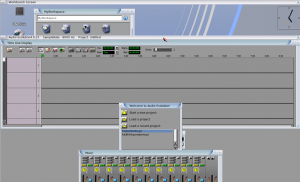 The Amiga. If you weren’t of computing age during the Bush Sr. administration, you may not have heard of this legend wrapped in an enigma wrapped in a white case. The Amiga inspired frenzied superlatives from its users (including, notably, pop artist Andy Warhol) in a way that only certain fruity computers do today. In fact, it’s often repeated that, if not for the business bungling of Commodore (who owned Amiga), we might today be reminiscing on the bygone days of Apple computers instead.
The Amiga. If you weren’t of computing age during the Bush Sr. administration, you may not have heard of this legend wrapped in an enigma wrapped in a white case. The Amiga inspired frenzied superlatives from its users (including, notably, pop artist Andy Warhol) in a way that only certain fruity computers do today. In fact, it’s often repeated that, if not for the business bungling of Commodore (who owned Amiga), we might today be reminiscing on the bygone days of Apple computers instead.
Now, I never owned an Amiga, unfortunately; in fact I despised Amigas and anyone who owned one, purely out of an unreasoning sense of sour grapes (the Amiga was, in some ways, more advanced than any computer I’d own for almost another decade). But now that time and tide have washed the vinegar from my teeth, I’ve been overcome with a bit of morbid curiosity about this platform of the past. And when I discovered that some fine folks had developed AROS, an open source remake of the Amiga OS, designed for standard PC hardware, I had to check it out.
AROS, like Linux and BSD, has multiple distributions — three to be exact. As it happens, the leading distro of AROS, Icaros, has recently released version 1.4, so I promptly installed it in QEMU and have been checking it out for a while.
Core system
Icaros boots almost instantly, even with modest hardware resources allocated. This is probably owing to its extreme simplicity: the system has no concept of user accounts, runs no network services, and just in general isn’t starting up a whole lot of software when it boots. Still, let’s give it credit: it’s speedy on the boot-up.
The AROS filesystem is simple and straightforward, something like DOS or Windows but using disk labels rather than drive letters. So your main partition is called SYSTEM:, and you can have a separate WORK: partition (like /home, I guess) if you wish. Everything is arranged in a neat heirarchy, with all the messy libraries and program data files swept under the virtual rug as hidden files. All you see browsing around are executables and your data. This takes a little getting-used-to for a Linux user, but one can obviously see the logic of it.
As a Linux user, I naturally launched the shell application first, to see if I could dig around a little under the hood. The AROS command line is it’s own thing; it struck me as closer to DOS than POSIX, but with a whole set of commands all its own. Icaros is definitely more GUI oriented anyway, so I decided to give up on the shell and check out the GUI instead.
Icaros comes with GUI tools to configure things like networking, USB, desktop preferences, etc. These can all be found under the “System” menu, though I’d recommend keeping the manual handy when you work with them, as they aren’t the most intuitive interfaces I’ve ever seen.
One nifty feature on the desktop is a RAM disk drawer (note: they aren’t folders on AROS, they are drawers. Same thing, different metaphor.) on the desktop. This is a handy chunk of memory that you can access just like a drawer on the disk, but of course it’s obliterated whenever you reboot. Not sure how useful that is in the days of multi-terabyte SATA drives, but it’s a neat idea all the same.
The Icaros Desktop
Icaros’ desktop, Wanderer, is an evolution of the original Amiga Workbench desktop. At first glance it seems pretty much like any other desktop environment you’ve ever used, but there are some subtle-yet-important differences.
First, right-click works quite a bit different than I’m used to. Instead of popping up a context menu, a right click toggles an application’s global menu, which appears at the top of the screen Apple-style.
The other oddity is window management. Apart from the obligatory “close” button, the window decorations contain an iconify button (minimizes the program to a desktop icon. You might remember this from Windows 3.1, or NeXTStep-like environments), a “size toggle” button (which seems to toggle between the largest size you’ve resized a window and the smallest), and a “raise to the front” button, which struck me as slightly pedantic. Notably missing is anything resembling “maximize”, which I found increasingly annoying. I’m not particularly enamored of the way Icaros does window management; granted, I’m used to a tililng window manager, but even compared to conventional desktop environments it seemed to require a lot more mousing about to arrange windows than I want to do.
Icaros sports a launcher/dock type gadget at the bottom of the screen called “amistart”, which as I understand it was not part of the original Amiga workbench. It’s pretty much what you expect, though I kind of like the way the “start menu” works — because the filesystem is basically laid out like a menu structure, and “support files” are hidden, the menu is just a glorified file browser. You can use it like a normal menu, or click on any folder in the menu to just open that folder in a file browser. Kind of nice if you want to check out a bunch of programs under a certain folder, and don’t want to have to keep navigating to it on the menu.
The file browser is minimal, and can operate in a modern “browse” mode, or the classic “spatial” mode (spatial file browsers basically open a new window for each folder you open, which back in the 90’s was somehow believed to be more user friendly. Especially for users who love playing a good game of “click all the X’s” after digging about for a lost file.)
By far the coolest feature of the Icaros desktop is how it handles multiple workspaces. Instead of chucking them on a cube or grid, additional workspaces are stacked up, and can be accessed by sliding the top ones down from the top. It kind of reminds me of those lecture-room blackboards at big colleges that can slide up and down to reveal additional blackboards beneath.
Applications

Audio Evolution running on Icaros. Notice it's on its own screen, which I've pulled down a bit to show the desktop beneath. (click for larger image)
Well window managers and launchers are all fine and good, but not much use without something to launch and manage. Considering its relative obscurity, Icaros pleasantly surprised me with the volume of applications available. The “full edition” (Icaros Live, not Icaros Light) that I installed is chock full of programs that span the gamut. I was honestly hoping to find one or two real gems among Icaros’s programs that would make me say “I need to have one of my computers booting this so I can check out this application”. The jury’s still out on whether I’ve found any, but nevertheless there’s a good selection of stuff:
- Web browser: Yes, it has a web browser, so it’s not a totally useless OS :-). Odyssey web browser, or OWB, is basically webkit wrapped in a chunky 90’s-esque UI. But apart from the obvious lack of proprietary plugins and codecs, it works just like any other webkit browser.
- Other network: Icaros has a decent POP/IMAP mail client, and clients for IM, IRC, FTP, Remote desktop, and VNC. I didn’t find the SSH client, but there were a few things I couldn’t identify so who knows. (NOTE: the most recent release, 1.4.1, also adds support for Windows file sharing (SMB) as well).
- Games: there’s a nice selection of games installed in Icaros; most of them are ports of open source games available on other platforms (SupertuxKart, Blob wars, Doom, etc) or original versions of old standards (solitaire, chess, etc). Nothing to impress the L337 94/\/\3r crowd, but you can have some fun nontheless.
- Emulators: Here we have a nice feature of Icaros: eighteen emulator programs covering a wide variety of classic home computers, consoles, game systems, and operating systems. Nothing you can’t get for other operating systems, but here they are packaged, configured and apparently sporting the necessary ROMS to function.
- Multimedia: Being a musician myself, and knowing the Amiga was at one time a top-line multimedia machine, I was eager to see what music making software Icaros held. There are some mod trackers, a 303 emulator, a drum synth, and a serviceable multitrack DAW (Audio Evolution 4). The selection didn’t blow me away, but if anything tempts me to put Icaros on real hardware, it’s the idea of doing some music Amiga-style.
- Graphics: Icaros comes with several paint/draw sort of applications, none of which seemed either stunningly better or egregiously worse than Gimp, Paint.NET, or any of a dozen other free paint applications for other platforms (at least in my limited non-artist assessment).
- Other: Text editor, PDF viewer, ZIP archiver, CD burner, disk formatter, etc — all those little applications you never think about needing until you need them. Icaros has them, no worries.
- Development: A Lua interpreter is included, as well as the SDL libraries. Vim has been ported, but sadly no Emacs :-(. There is a weirdly cartoonish IDE called Murks, and a number of other tools with obtuse names whose purpose was not clear to me (like “Chocolate Castle” ?¿?).
Overall Thoughts
What’s the point of Icaros? Is it a nostalgic curiosity? The up-and-coming desktop of the future? A niche OS for a small community of holdouts? Hard to say, really; but for anyone with a spare computer and fond memories of (or burning curiosity about) the Amiga, it’s almost certainly worth spending a rainy afternoon with, at the very least. It’s also a good candidate for that old-and-dusty PC that’s too slow for your favorite OS.
By all means, if you have the time and inclination check it out! You can find the software here, and an excellent must-read-first manual here. Let me know how it goes!



One Thought on “Icaros Desktop 1.4”